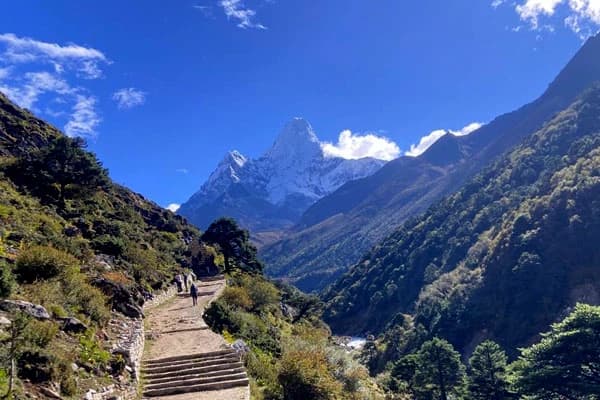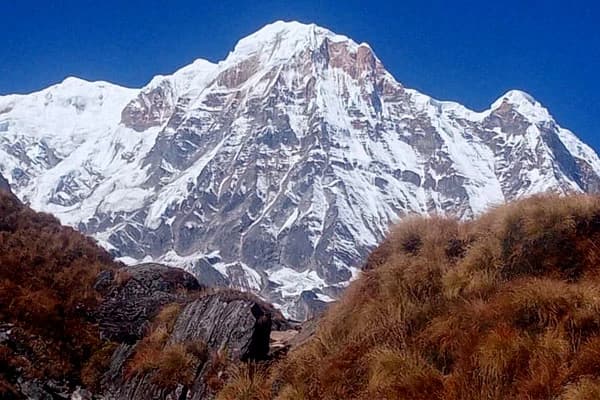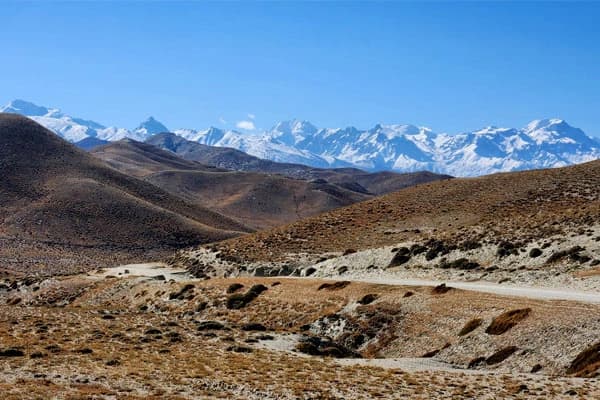Daily Distance on the Annapurna Base Camp Route: You Need to Know
The distance and elevation gain during the trek to Annapurna Base Camp vary depending on several factors, and mainly the route you undertake, as per your itinerary, is set. As many people prefer to choose the standard trail, covering every corner of the Annapurna region, as it also, gets you to a short Ghorepani Poon Hill Trek at the same before leading to the foothill of the world's 10th heighest peak. Here is the detailed overview in the summary table and short explanation overview demonstrating the distance you cover, daily hiking hours, and the elevation gain at the same time:
|
Day
|
Route
|
Distance in Km
|
Duration in Hours
|
Elevation in metres
|
|
2
|
Drive to Pokhara
|
65
|
7- 8
|
824
|
|
3
|
Drive to Birethanti and trek to Ulleri
|
11
|
6- 7
|
2,040
|
|
4
|
Trek to Ghorepani
|
10
|
5- 6
|
2,864
|
|
5
|
Hike to Poon Hill and Trek to Tadapani
|
12
|
6-7
|
2,630
|
|
6
|
Trek to Chhomrong from Tadapani
|
8
|
4-5
|
2,140
|
|
7
|
Trek to Dovan via Bamboo
|
12
|
5-6
|
2,430
|
|
8
|
Trek to Machhapuchhre Base Camp
|
10
|
4-5
|
3,760
|
|
9
|
Trek to Annapurna Base Camp
|
6
|
3
|
4,130
|
|
10
|
Trek to Bamboo
|
20
|
7-8
|
2,310
|
|
11
|
Trek to Jhinu Danda
|
12
|
5
|
1,780
|
|
12
|
Trek to Siwai and Drive to Pokhara, then flight to Kathmandu
|
30
|
5
|
824
|
Day 02: Drive - Kathmandu to Pokhara
It takes 200 kilometers to drive from Kathmandu to Pokhara. Pokhara is situated lower than Kathmandu which stands at 824 meters above sea level. Stunning mountains, plentiful rivers, and luscious green fields will be seen along this route. The total drive time is about 6 to 7 hours.
Day 03: Drive to Birethanti and hike to Ulleri
The journey starts with a drive of 42 kilometers from Pokhara to a place called Birethanti which takes 1.5 hours on rough mountain highways. Next, you begin the real hike! Climbing Ulleri village means hiking about 8 kilometers on an uphill path. Ulleri is located at 2040 meters above sea level. You’ll climb many steps that are built from stone and there are hanging bridges over the rivers.
Day 04: Ulleri to Ghorepani (Hike)
The trail from Ulleri to Ghorepani at 2,864 meters is about 7 kilometers long, passing the forested area, small cascading waterfalls, river streams, and rhododendron forests. You should be ready for hiking up tough hills and walking along narrow mountain trails for 5 to 6 hours.
Day 05: Ascend- Poon Hill and Tadapani (Hike)
In early morning, head up 1.5 kilometers to Poon Hill to enjoy the sunrise over large mountains. After that, you return uphill for a short distance, then continue 9 kilometers to Tadapani village. Tadapani is situated 2630 meters above the sea. Along the trail are lovely forests with chances to spot both monkeys and colorful birds.
Day 06: Tadapani to Chhomrong (largest gurung settlement in Annapurna region)
From Tadapani, you must descend 9 kilometers to the Chhomrong village. You will drop down from Chhomrong since the village is located at 2,140 meters. But realize that it’s not that simple. You must enter into a low valley and come back over the higher ground. It is from this village that you’ll walk to Annapurna Base Camp and its location offers a wonderful view of the mountains.
Day 07: Hike- Dovan via Bamboo
You are going to hike 11 kilometers today inside a valley. You need to go first to Bamboo village and then proceed to Dovan. Dovan is perched at 2430 meters above sea level. You will follow a rapid river and walk among thick bamboo for about 5 to 6 hours. As you travel along, the narrow road is rocky and you have to cross a few small bridges.
Day 08: Trek - Macchapuchare Base Camp (Lap of the Mount Fishtail) to ABC (Annapurna Base Camp)
Today, the route to Macchapuchare Base Camp at 3760 meters takes 7 kilometers and will take around 4 to 5 hours. You are near the highest point right now! You can feel the air is thinning and you might be breathing a little harder. You pass from green forested areas to areas covered with rocks and snow-topped peaks.
We have reached the day we have been looking forward to! You cover the 2 kilometers to Annapurna Base Camp which is at a height of 4130 meters, in around 3 hours. It’s the most important and memorable part of your journey. Mountains towering all around reach toward the highest point in the sky. Because of the thin air here, you might get a bit lightheaded.
Day 09: ABC - Bamboo (Hike)
It’s time for us to go back down now! Walking for around 7 to 8 hours, you get to Bamboo village which sits at 2310 meters, after leaving base camp 14 kilometers behind you. We keep hiking downhill all day. Your knees might ache, but the air will seem heavier and simpler to breathe.
Day 10: Hike to Jhinu Danda (Natural Hot Spring)
You start the trek by walking from Bamboo, and it takes you 8 kilometers to the Jhinu Danda village at 1780 meters. It stands out thanks to its hot natural springs. The springs are about a 20-minute walk below the village and a perfect way to unwind after a long trek.
Day 12: Descend down to Siwai and Take a Drive to PKR (Pokhara)
It takes 3 kilometers of walking from Jhinu Danda to reach Siwai village at 1700 meters. The hike is very short and doesn’t require much effort. Then you board a jeep and return to Pokhara, which is a 70-kilometer drive. The journey will take around 3 hours. At the end of the day, you go back to Kathmandu by air.
How Terrain And Altitude Influence Distance and Pace for the Annapurna Base Camp Trek?
Something is fascinating about trekking in the mountains because the terrain makes an enormous difference in your speed. Think of it this way, at home, when you walk on a flat sidewalk, you probably can walk pretty fast without getting tired. But when you start walking up a steep gradient, the speed decreases, and the heavier breaths follow! ABC Trek is nothing but an extension of this kind of experience.
Every day terrain is different on the ABC Trekking trail. Sometimes you might be walking on dust trails in the forest, other times you would be doing some serious scrambling over boulders or climbing up thousands of stone steps. On a rocky, steep track, you may cover only one kilometer in an hour, whereas on a smooth surface, you may cover 3 or 4. Your feet must now tread carefully, and your legs have a much harder time pushing you uphill.
It’s interesting to know that the air you breathe gets less oxygen as you go higher in mountain trekking. At sea level, where the average lies, our bodies are accustomed to a certain amount of oxygen. But up to 4000 meters high, like the Annapurna Base Camp, nearly 40% less oxygen is available! The body is working much harder just during a regular act of breathing. This would, therefore, mean that you will have to walk slower and take more breaks despite being incredibly fit. It happens to everyone and is normal, even to experienced trekkers. However, for a longer and more challenging expedition, you can combine the Annapurna Circuit Trek with this trek to Annapurna Sanctuary, as many individuals prefer this way for an extended version.
What are the common factors that influence the Daily Distance?
Different factors to consider when you’re hiking in the mountains can determine how much you can walk each day. It’s more than just starting your journey and wishing that it works out! Having an idea of these factors enables you to organize your hike better and have more fun.
Starting Point - Trekking Kick off from the beginning point
The initial part of the journey to the Annapurna Base Camp usually determines the level of enjoyment they will get out of the trek. People mostly decide between the following two main ways to explore the Annapurna region. One is out of Kathmandu, the throbbing capital city of Nepal, and the other from Pokhara, the beautiful lake town quite close to the mountains.
From Kathmandu, you’ll begin your journey at an altitude of over 1,300 meters above sea level. From here, you need to drive or fly for almost 200 km towards the starting point of the actual trek, thus it requires you to put in a full day of travel before setting out on your walk.
Starting the Annapurna Base Camp Trek from Pokhara for 5 days is quite another experience. Pokhara sits at only 824 meters and is lower than Kathmandu! The beautiful part? You get to see big snowy mountains right from the town! You can reach your beginning point for trekking from Pokhara in just 1.5 hours, so you don’t waste much time traveling.
Transportation: Flight Vs Drive
How you enter the starting point already consumes energy and time to could be spent on trekking. You have two main routes from Kathmandu to Pokhara, and those route changes the whole experience and just feel different!
From Kathmandu to Pokhara, the flight is so fast and so easy that the plane takes around 25 minutes with breathtaking views of mountains and green valleys on one side. Just be aware that the tickets can be more expensive and that random flights may be delayed due to the weather.
Driving from Kathmandu to Pokhara is an adventure by itself. It takes about 6 to 8 hours on winding mountain roads. Through the journey, you'll see villages, rivers, and terraced farms and forests. The road goes up and down through hills, and you might feel sick because of all the turns. But you get to see real Nepali life en route.
Weather Condition
The weather in the mountains can turn from good to bad very quickly! Changes in the weather during your hike can affect your daily walking distance and the time you have fun.
During spring and autumn, the weather remains mostly dry, and the sky is clear with spectacular mountain views. Every devotee wishes to walk fast and cover as many sights in the daylight since the paths are dry. But from June to September, it becomes too difficult due to the rains. It’s like walking on slippery, muddy soil. Heavy showers can obstruct your view to just a few meters ahead. Rivers are becoming wider and more difficult to pass. It often takes longer to walk because you need to pay extra care not to trip. During winter, thick snow can make the trail hard to follow or quite dangerous, so guides may decide to go further the next day.
Trail Condition
It is the state of the mountain path that can make you cover more or less distance every day. You may find that trails are different, not just from one season to another, but also day by day. Usually, the trails in the lower areas are pretty easy to navigate. People in the village have made steps from stones and put up wooden bridges over rivers. Many people use these paths, so they are well looked after. You will find that walking at a steady pace allows you to walk farther. The higher you go up the mountains, the trails become uneven and filled with stones that need careful and slow walking. Weather changes affect the experience you have on any trail. After it rains heavily, the paths get slippery and covered in mud. Snow and ice can turn some high areas into hazards, so it’s important to be extra careful. At times, landslides fall across the trail, so you may have to follow a longer detour.
Acclimatization And Pace
The trekking pace and the time it takes for acclimatization can make the Annapurna Sanctuary Trek longer or shorter. Being fit, experienced and able to handle altitude helps you walk more and cover more distance every day. Remember, walking speed is not the same for everyone! Some people manage to walk fast and cover larger distances in a day. It’s common for some people to take it easy and shoot photos as they go. Kids generally take their time walking when compared to grown-ups.
Considering the altitude change, time must be allowed for your body to get used to it. Thus, acclimatization is a must! Most trekking guides will take a day or two at an altitude site for the rest, sometimes going a bit higher and then coming back down. By giving your body time to rest, you reduce the risk of getting altitude sickness. As a result, you need to plan breaks and walk at a moderate speed to avoid risks and explore as far as you can.
Different Routes to Annapurna Base Camp and Their Route Variations
Reaching Annapurna Sanctuary isn’t the same as following one set route. A few routes save you time, but others take a bit longer and show many gorgeous spots. Fully selecting either route changes the number of kilometers you walk each day and how many days your entire adventure takes.
Several hikers aim to go as quickly as possible to the base camp due to their limited vacation days. A few enjoy the slower option, wishing to stop at many mountain destinations, see different villages, and admire plenty of viewpoints. How fit you are, how much time you can take, and what you aim to do will help you find the best route for yourself.
Your distance of travel can range widely, depending on which walking path you take. The shortest route could only be a total of 60 kilometers, while the longest combined routes involve over 200 kilometers' walking!
Classic Route
This main route to Annapurna Base Camp is what most people decide to follow. The route takes you over about 110 kilometers of terrain in 12 to 14 days. You will travel from Nayapul to well-known villages like Ghorepani, Poon Hill, Tadapani and Chhomrong before getting to the base camp. People walk between 6 and 15 kilometers each day, depending on the itinerary. This is an ideal first trek for anyone since there are helpful tea houses, straightforward paths, and plenty of people to meet throughout the route.
This is the best choice for people aiming to get to ABC in only two weeks. The entire trek covers roughly 60 kilometers, but each day you need to walk much farther than that, from 12 to 20 kilometers on average. You generally hurry through parts of the route and miss the astonishing villages that are usually seen in tourist guides. Since the trail from Jhinu Danda to the base camp is mostly uphill, your legs had better be prepared to climb all the time. If you want more exposure, then you should consider, Mardi Himal and ABC Trek.
Adding Poon Hill
if you want to see the stunning sunrise view of over 19 notable peaks, Annapurna Base Camp Trek via Poon Hill is the one! Though you cover approximately 15 kilometers more than if you took the main route. At 4 AM, people begin the climb uphill with a flashlight for 1.5 kilometers so they can watch the sunrise from the top. Then you walk down the same trail you took to come up. This change adds just over 125 kilometers to your total trail distance. Climbing the additional distance is worth it, simply for the views from Poon Hill.
Combining with the Mardi Himal and Khopra Ridge Trek
ABC with Mardi Himal Trek and Khopra Ridge Trek is equal to choosing the top mountain tour deal! When you add up all these trails, you’ll walk approximately 180 to 200 kilometers in about 18 to 21 days. At three different base camps, you will get various views of the mountains. Whether it’s 8 km or 16 km, the day’s distance differs. Mardi Himal stretches your trip by about 40 kilometers, and Khopra Ridge adds another 50 kilometers. People who choose this trail usually have a lot of time and hope to see all that the Annapurna region can offer.
Merge with the Annapurna Circuit Trek
The Annapurna Base Camp and Annapurna Circuit Trek is a mountain marathon! The fusion of Annapurna Base Camp Visit with an end-to-end Circuit Trek creates a heavy-duty trek of about 230 kilometers stretched over 20 to 25 days. You will traverse the famous Thorong La Pass at a height of 5416 meters and see the Annapurna Mountains from both sides. Distances covered each day range from 10 to 18 kilometers, pushing some days to be very high altitude and hard.
Note: Destination Himalaya Treks and Expedition tends to offer all the Annapurna region trekking packages, ensuring that you cover every aspect of the Annapurna region with ease!
Plan your trek, Distance Based on Fitness Level
While setting out on the ABC Trek, you need to be honest about what your body can endure. Think about your usual walking hours. Can you walk for two hours without becoming unusually tired? Does walking up stairs feel easy for your legs? If your heart races walking uphill somewhere in the neighborhood, then it will be a sad story in the mountains. But if you cannot, do not worry, as you can gain strength before the trek. Begin walking more each week. Try hiking local hills on weekends as this will strengthen your legs and lungs.
Each person’s fitness needs vary, so the plan can’t be the same for all of them. If you work out often and are already fairly fit, most difficulties with the standard 12-day trek can be handled by you. But, if physical activity is not anything that features into your daily or weekly routine-on average, it may be that you want to build in some extra rest days or pick a shorter route. Some folks take 15 or even 20 days to complete the very same trek, and that's fine! The mountains are not going anywhere.
In fact, during the trek, listen to your body. If you are feeling really tired or have headaches due to the altitude, extend your rest time or take a day off if you can. Above anything, stay safe and well. This is supposed to be fun, after all, as it is not a physical test for your body!
Tip 10: Tips for Managing Long ABC Trek
- Look for a competent guide from the area who is aware of the surroundings, weather and the most suitable places for resting on the trail. A good guide will avoid making you wander off track so that the trip is shorter.
- Start your walk on shorter hiking days 5-6 hours. This way, your body gradually adjusts to the walking and the altitude. Your body will appreciate you once you get to more challenging treks.
- Choose to begin your hike at 7-8 AM so that you arrive at your destination before the weather gets hotter in the early afternoon. If you wake up, eat and go to bed at the same times each day, your body will get used to the travel schedule.
- Take only your necessary assets and try to keep your backpack lighter than 10-12 kg. If the weight of your baggage is too much for you, consider hiring a porter.
- Consume 3-4 liters of water and include such foods in your diet, so you don’t lose energy when in a higher-altitude location.
- Use trekking poles to relieve your weight off your knees and help you balance on rocky paths more effectively. They make helping you walk further with less pain easier, especially going downhill.
- Carbohydrates such as rice, pasta and potatoes help you gain energy for walking. Try to have a nice breakfast and take with you snacks such as nuts, chocolate bars and energy bars to eat along the way of the day.
- Days for acclimatization should be planned, especially after you reach places higher than 3,000 meters. Acclimatizing gradually can help lower the chances of altitude sickness, delaying or even abandoning your hiking trip.
- Try to be at the pace of your steps when you breathe. This takes your body into getting the oxygen required and makes it easier to walk uphill.
- Check weather updates every morning at the tea houses or from the guides so that your day can be planned accordingly.
Recommended Daily Hiking Hours
Most highly experienced guides recommend 5 to 7 hours of walking each day on the Annapurna Base Camp trek. This sounds like a lot of walking, but mountain walking is substantially slower than normal walking, and breaks will be necessary for bouncing back from exhaustion, clicking photographs, or munching on some snacks.
The key breakfast time is to set sail from the hotel early in the morning, usually at 7 or 8 A.M., when the weather is nice and clear. Walk 2-3 hours and remain at a tea house for lunch. After lunch, one would walk 2-4 hours more to the lodging for the night. With this schedule, you can relax for a while, stroll around the village, and hit the sack early. It is not a race because the mountaintops will be there to welcome you, whether you make it in 5 hours or take 8!
Packing List to Overcome the ABC Trek Elevation Challenge
- You need a sleeping bag rated below -10°C (14°F) for the trip. The tea houses supply blankets yet these items do not provide adequate protection from the cold.
- Higher elevation exposes you to extremely powerful sunlight. Wear protective sunglasses for UV rays and apply SPF 50+ sunscreen while carrying a sun hat with a wide brim.
- Carry 2 liter capacity water bottle and keep water purification tablets or purchase a filter for your water before your journey.
- Layers of cold-weather clothing should include thermal underwear along with hiking pants and a fleece jacket but you will need a down jacket and outer waterproof layer too.
- Choose waterproof trekking boots that provide high ankle support for your trek. Start wearing your boots at home for two or three weeks in advance so they break in properly.
- Instead of packing large items, try bundling your clothes. Include a warm base layer, a mid-layer of fleece, and a waterproof/windproof outer jacket in your clothes.
- Bring a power bank so you can charge your phone, camera, and similar devices. Power isn’t always available when you sto,p and a few teahouses make you pay for electricity.
Conclusion: Final Say
Distances and routes for your Annapurna Base Camp Trek are a crucial factor when making a smarter choice for your mountain adventure! While the classic 110-kilometer route may suit all, shorter 60-kilometer express options and longer 200-plus kilometer combined routes are now in the options shortlist. Daily distances vary accordingly; from a challenging 20 kilometers on the quickies to a relaxed 8 kilometers on the laid-back.
Because the route you choose utterly changes your sightseeing experience, either the 60-kilometer direct route or the amazing 230-kilometer circuit adventure, choose a distance comfortable for your fitness and time. The mountains do not care whether you arrive fast or slow; they will be just as beautiful!
Short or long ABC Trek Distance, Destination Himalaya Treks and Expedition has all kinds of packages for you. Contact Us now!




